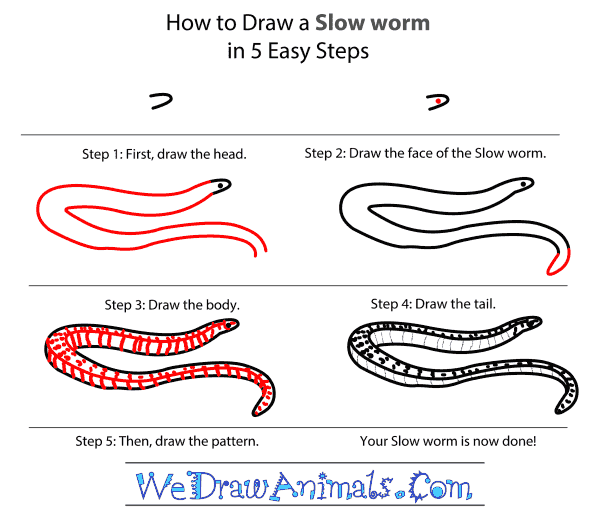In this quick tutorial you'll learn how to draw a Slow Worm in 5 easy steps - great for kids and novice artists.
The images above represent how your finished drawing is going to look and the steps involved.
Below are the individual steps - you can click on each one for a High Resolution printable PDF version.
At the bottom you can read some interesting facts about the Slow Worm.
Make sure you also check out any of the hundreds of drawing tutorials grouped by category.
How to Draw a Slow Worm - Step-by-Step Tutorial
Step 1: Let's start with the head. It's easy, just draw a small open oval.
Step 2: Now for the face. Simply draw a small circle for the eye.
Step 3: Draw two long lines that curve to the right for the body.
Step 4: Then, draw the tail by connecting the body.
Step 5: Now you can draw the pattern. The slow worm's body is flat on top so draw a line and add some dots. Then, draw squigly vertical lines for the pattern on both sides.
Interesting Facts about the SLOW WORM
The Slow Worm is a member of the reptile family and the scientific term for them is Anguis fragilis. Despite the indication of the proper name, this animal is a lizard. Other common names for this species are the Slow-Worm, Slowworm, Blind Worm, and Blindworm. They are native to Europe and Asia, have a light brown color, but no limbs. The body is very long, causing the appearance of the animal to resemble a snake. However, it has eyelids, mobile eyeballs, visible ears, an internal tongue, a detachable tail, no teeth, and doesn’t shed its skin, like a lizard.
Did you know?
- The animal was first documented in 1758.
- This species can live up to 30 years old in the wild.
- They can live up to 54 years old in captivity.
- The lizard was introduced to Ireland in the 20th Century.
- They can grow up to more than 1.5 feet long.
They can be identified from their age and gender by the coloration. The young ones have golden scales on top, while the males possess blue spots on their back. These lizards are mostly nocturnal, but like to bask in the sun during daylight. Otherwise they stay under rocks or logs, eating mostly snails and slugs. Their main enemy is the Cat.






